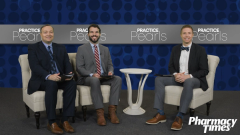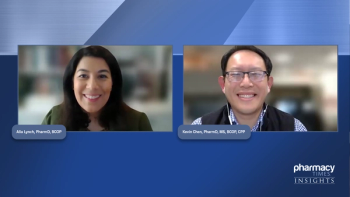
Optimizing Clinical Pathways and Analyzing Quality of Life for Patients with MM
Multiple myeloma clinical pathways and factors affecting patient quality of life are explored by an expert panel.
Ryan Haumschild, PharmD, MS, MBA: As we talk about clinical pathways, there’s more than just treatment. There’s clinical decision support. There’s sometimes navigation that you’re taking into consideration for each unique therapy. Dr Anderson, how are these clinical pathways or formulary decision supports being used by your practice to drive the utilization of high-value therapies in multiple myeloma [MM]? We talked about building in labs and monitoring, maybe ongoing oral assessments for patients that might be on IMiDs [immunomodulatory drugs], or even evaluating the social determinants of health for some patients who have been on therapy that maybe haven’t shown up for their most recent subcutaneous injection. So, my question is, how are you utilizing pathways in your practice? How are these tools even more specifically applied within the context of proteasome inhibitors within the relapsed/refractory [RR] setting?
Larry Anderson, MD, PhD, FACP: Part of it is we can use these plans in our EMR [electronic medical record] to determine what percentage of patients we’re giving certain types of therapies. We can pull out how many patients are getting fourth-line therapy, or third-line therapy. Are we actually doing the surveillance for these patients that we need? We’re building things into the plans to make sure that they’ve had their cardiac biomarker monitored, and things like that. If they’re on carfilzomib [Kyprolis], for example, are we watching for toxicity? A lot of these things make it more foolproof by just building in some of these assessments and periodic monitoring without having to remember.
Ryan Haumschild, PharmD, MS, MBA: And do you stratify your patients on proteasome inhibitors based on whether they have aggressive vs indolent disease?
Larry Anderson, MD, PhD, FACP: Yes. Certainly the patients with indolent disease, we may be more likely to use, for example, a triple oral proteasome inhibitor combination, and for someone with aggressive disease we’ll probably go with the intravenous [IV] proteasome inhibitor and get a rapid response hopefully. And those patients that are having a more aggressive symptomatic relapse are often more likely to accept going on to more cumbersome routes of administration of their therapy as well.
Ryan Haumschild, PharmD, MS, MBA: Dr Anderson, one of the common threads we’ve had throughout this entire conversation is considering the patient and patient-specific factors. My question to you is, are there some particular patients that you think would benefit from the use of one proteasome inhibitor vs another when we are considering the treatment plan?
Larry Anderson, MD, PhD, FACP: Definitely. Their baseline comorbidities, neuropathy, or their cardiac history, all those things come into play on deciding which proteasome inhibitor, and what the patient’s willing to do, a subcutaneous route of administration. Oral is always going to be an easier option for those patients and a lot easier than convincing them that it’s going to be something they can stick with. But certainly, in those patients that have an aggressive relapse, and we need to do the IV, then often they’re willing to do that.
Ryan Haumschild, PharmD, MS, MBA: As we think about these patients living longer, which is the ultimate goal, and we’re using combination therapies, we also want to think about not just wanting this patient to live 30 more years or 20 more years or 10 more years, because this is a disease of aging, but Dr Hinojosa, we care about the quality of life for these patients. Could you describe the quality of life or things that you’re considering for RR MM patients, and maybe even differentiate what quality of life indicators you’re looking at with someone with an indolent relapse versus an aggressive relapse?
Gabe Hinojosa, PharmD, BCOP: Absolutely. Quality of life and managing a good quality of life and giving them the best years that we can is certainly a top priority at all times and is always going to be at the forefront of our thought when making a treatment selection as we’ve talked about many of these patients specific factors. I think that if we boil down the majority of these patient-specific factors we’ve discussed today into a nutshell that 1 word or phrase would be quality of life and maintaining that. Certainly, a lot of that is going to correlate directly with the amount of time that the patient is spending either on the road traveling to and from our center or with us directly. Specifically in that indolent relapse, being able to target and use that triple oral regimen and capitalize on the oral route of administration for some proteasome inhibitors is going to be very helpful in maintaining that quality of life if it’s an appropriate patient that we trust will respond to that. There’s a balance to all of these things. Of course, we want to make sure that we are treating the disease effectively. Because other factors that could impact the quality of life poorly would be as we advanced through relapse, we could have more bone lesions come up. Maybe they haven’t had bone lesions before, and now they’re experiencing these new pains, managing this pain, managing fractures, things like that long-term become very important so that we can keep up the patient’s long-term activity and baseline activity. If I have a patient that loves to be outdoors, they’re a big golfer, and maybe they’re trying to be as active as they can, so that’s one thing that we’re going to discuss. Looking at supportive care for those patients also, and how do we prevent some of these bone lesions long term and focus our supportive care needs on improving quality of life and not just focusing solely on the treatment selected.
Ryan Haumschild, PharmD, MS, MBA: It’s so hard sometimes because we can have the blinders on. What did the data say? What was the hazard ratio? But really considering the patient in front of us and those unique needs. As you said, what are the goals for that patient? Do they want to be active or not? Do they care about overall survival, and are willing to do whatever it takes? I think those are great conversations. I think also talking more upfront with patients, here are some of the adverse effects that you might incur during your treatment. Here are things I want you to be aware of. We may dose reduce—that's not necessarily a bad thing. We want to make sure that you don’t develop underlying toxicities that could compromise the treatment plan. I think you really hit on a lot of that when you boiled it down.
Transcript edited for clarity.
Newsletter
Stay informed on drug updates, treatment guidelines, and pharmacy practice trends—subscribe to Pharmacy Times for weekly clinical insights.








































































































































































































